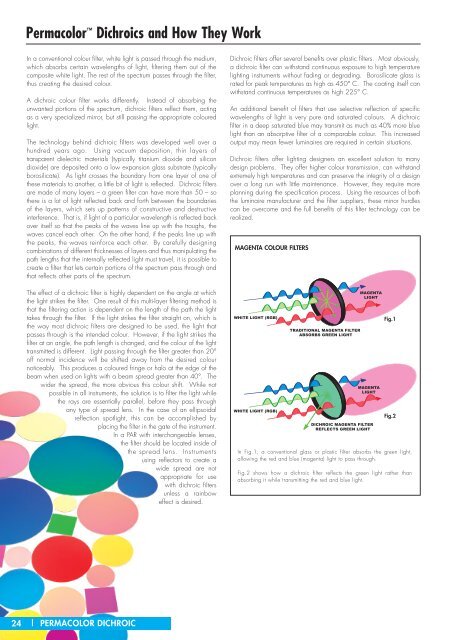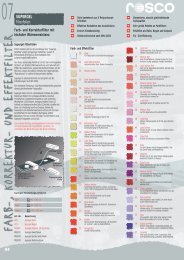Lighting the Acting Areas - AudioMaster
Lighting the Acting Areas - AudioMaster
Lighting the Acting Areas - AudioMaster
You also want an ePaper? Increase the reach of your titles
YUMPU automatically turns print PDFs into web optimized ePapers that Google loves.
24<br />
Permacolor Dichroics and How They Work<br />
In a conventional colour filter, white light is passed through <strong>the</strong> medium,<br />
which absorbs certain wavelengths of light, filtering <strong>the</strong>m out of <strong>the</strong><br />
composite white light. The rest of <strong>the</strong> spectrum passes through <strong>the</strong> filter,<br />
thus creating <strong>the</strong> desired colour.<br />
A dichroic colour filter works differently. Instead of absorbing <strong>the</strong><br />
unwanted portions of <strong>the</strong> spectrum, dichroic filters reflect <strong>the</strong>m, acting<br />
as a very specialized mirror, but still passing <strong>the</strong> appropriate coloured<br />
light.<br />
The technology behind dichroic filters was developed well over a<br />
hundred years ago. Using vacuum deposition, thin layers of<br />
transparent dielectric materials (typically titanium dioxide and silicon<br />
dioxide) are deposited onto a low expansion glass substrate (typically<br />
borosilicate). As light crosses <strong>the</strong> boundary from one layer of one of<br />
<strong>the</strong>se materials to ano<strong>the</strong>r, a little bit of light is reflected. Dichroic filters<br />
are made of many layers – a green filter can have more than 50 – so<br />
<strong>the</strong>re is a lot of light reflected back and forth between <strong>the</strong> boundaries<br />
of <strong>the</strong> layers, which sets up patterns of constructive and destructive<br />
interference. That is, if light of a particular wavelength is reflected back<br />
over itself so that <strong>the</strong> peaks of <strong>the</strong> waves line up with <strong>the</strong> troughs, <strong>the</strong><br />
waves cancel each o<strong>the</strong>r. On <strong>the</strong> o<strong>the</strong>r hand, if <strong>the</strong> peaks line up with<br />
<strong>the</strong> peaks, <strong>the</strong> waves reinforce each o<strong>the</strong>r. By carefully designing<br />
combinations of different thicknesses of layers and thus manipulating <strong>the</strong><br />
path lengths that <strong>the</strong> internally reflected light must travel, it is possible to<br />
create a filter that lets certain portions of <strong>the</strong> spectrum pass through and<br />
that reflects o<strong>the</strong>r parts of <strong>the</strong> spectrum.<br />
The effect of a dichroic filter is highly dependent on <strong>the</strong> angle at which<br />
<strong>the</strong> light strikes <strong>the</strong> filter. One result of this multi-layer filtering method is<br />
that <strong>the</strong> filtering action is dependent on <strong>the</strong> length of <strong>the</strong> path <strong>the</strong> light<br />
takes through <strong>the</strong> filter. If <strong>the</strong> light strikes <strong>the</strong> filter straight on, which is<br />
<strong>the</strong> way most dichroic filters are designed to be used, <strong>the</strong> light that<br />
passes through is <strong>the</strong> intended colour. However, if <strong>the</strong> light strikes <strong>the</strong><br />
filter at an angle, <strong>the</strong> path length is changed, and <strong>the</strong> colour of <strong>the</strong> light<br />
transmitted is different. Light passing through <strong>the</strong> filter greater than 20°<br />
off normal incidence will be shifted away from <strong>the</strong> desired colour<br />
noticeably. This produces a coloured fringe or halo at <strong>the</strong> edge of <strong>the</strong><br />
beam when used on lights with a beam spread greater than 40°. The<br />
wider <strong>the</strong> spread, <strong>the</strong> more obvious this colour shift. While not<br />
possible in all instruments, <strong>the</strong> solution is to filter <strong>the</strong> light while<br />
<strong>the</strong> rays are essentially parallel, before <strong>the</strong>y pass through<br />
any type of spread lens. In <strong>the</strong> case of an ellipsoidal<br />
reflection spotlight, this can be accomplished by<br />
placing <strong>the</strong> filter in <strong>the</strong> gate of <strong>the</strong> instrument.<br />
In a PAR with interchangeable lenses,<br />
<strong>the</strong> filter should be located inside of<br />
<strong>the</strong> spread lens. Instruments<br />
using reflectors to create a<br />
wide spread are not<br />
appropriate for use<br />
with dichroic filters<br />
unless a rainbow<br />
effect is desired.<br />
| PERMACOLOR DICHROIC<br />
Dichroic filters offer several benefits over plastic filters. Most obviously,<br />
a dichroic filter can withstand continuous exposure to high temperature<br />
lighting instruments without fading or degrading. Borosilicate glass is<br />
rated for peak temperatures as high as 450° C. The coating itself can<br />
withstand continuous temperatures as high 225° C.<br />
An additional benefit of filters that use selective reflection of specific<br />
wavelengths of light is very pure and saturated colours. A dichroic<br />
filter in a deep saturated blue may transmit as much as 40% more blue<br />
light than an absorptive filter of a comparable colour. This increased<br />
output may mean fewer luminaires are required in certain situations.<br />
Dichroic filters offer lighting designers an excellent solution to many<br />
design problems. They offer higher colour transmission, can withstand<br />
extremely high temperatures and can preserve <strong>the</strong> integrity of a design<br />
over a long run with little maintenance. However, <strong>the</strong>y require more<br />
planning during <strong>the</strong> specification process. Using <strong>the</strong> resources of both<br />
<strong>the</strong> luminaire manufacturer and <strong>the</strong> filter suppliers, <strong>the</strong>se minor hurdles<br />
can be overcome and <strong>the</strong> full benefits of this filter technology can be<br />
realized.<br />
MAGENTA COLOUR FILTERS<br />
WHITE LIGHT (RGB)<br />
WHITE LIGHT (RGB)<br />
WHITE LIGHT (RGB)<br />
WHITE LIGHT (RGB)<br />
TRADITIONAL MAGENTA FILTER<br />
ABSORBS GREEN LIGHT<br />
TRADITIONAL MAGENTA FILTER<br />
ABSORBS GREEN LIGHT<br />
MAGENTA<br />
LIGHT<br />
MAGENTA<br />
LIGHT<br />
MAGENTA<br />
LIGHT<br />
MAGENTA<br />
LIGHT<br />
DICHROIC MAGENTA FILTER<br />
REFLECTS GREEN LIGHT<br />
DICHROIC MAGENTA FILTER<br />
REFLECTS GREEN LIGHT<br />
Fig.1<br />
Fig.2<br />
In Fig.1, a conventional glass or plastic filter absorbs <strong>the</strong> green light,<br />
allowing <strong>the</strong> red and blue (magenta) light to pass through.<br />
Fig.2 shows how a dichroic filter reflects <strong>the</strong> green light ra<strong>the</strong>r than<br />
absorbing it while transmitting <strong>the</strong> red and blue light.






